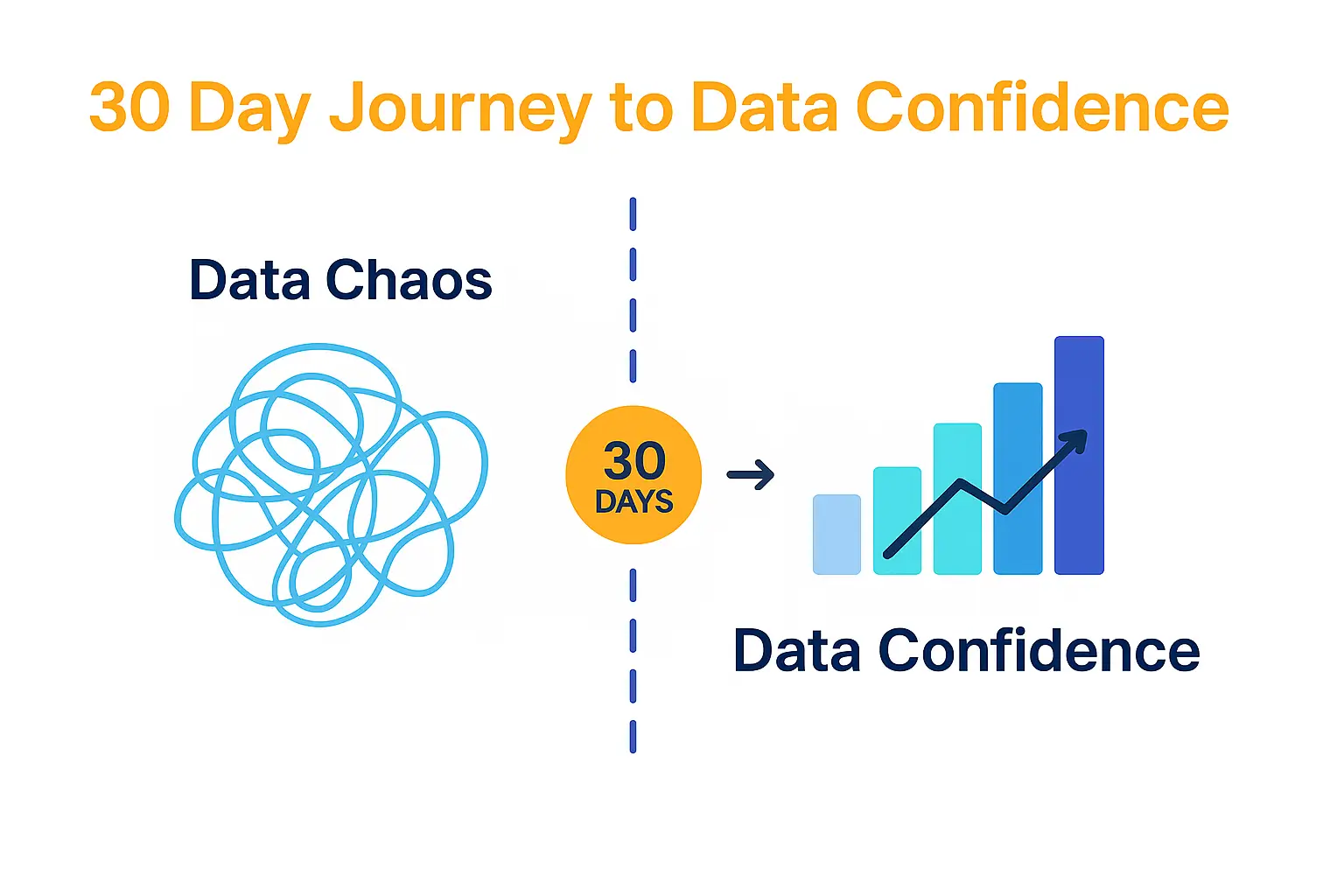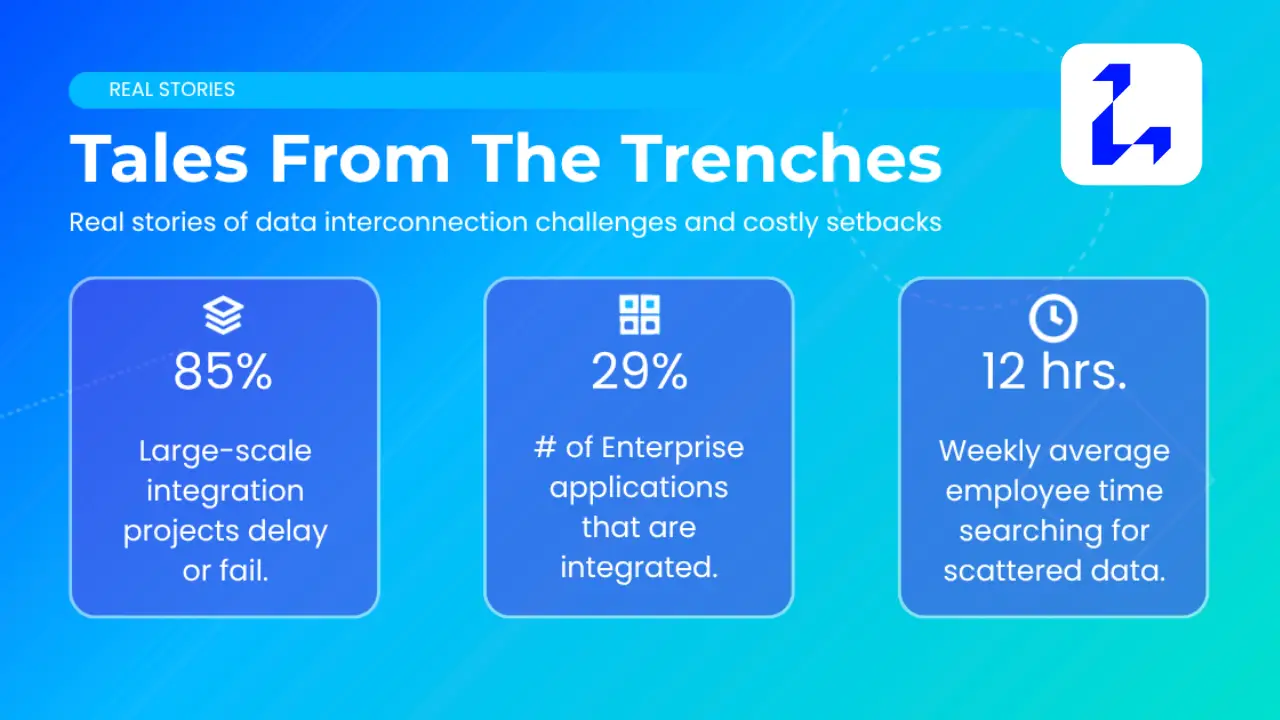Data has become the lifeblood of modern business. Yet, for many organizations, it feels less like a strategic asset and more like a chaotic mess. Reports don’t align, teams argue over “whose numbers are right,” and decisions take longer than they should.
The culprit? Weak or nonexistent data governance.
It’s not glamorous, but governance is the foundation that turns raw data into reliable intelligence. Without it, you’re building your strategy on sand. With it, you create the clarity, trust, and agility needed to compete.
The good news: meaningful progress doesn’t have to take years. With the right leadership commitment, your organization can see tangible improvements in just 30 days.
The Cost of Poor Data Governance
This guide outlines a step-by-step roadmap for leaders, highlighting common pitfalls, strategies to overcome them, and the profound business impact of doing governance right.
Before diving into solutions, let’s ground this in reality. Poor governance has measurable costs:
- Bad decisions: A 2023 Gartner study found that 60% of organizations have abandoned a data-driven initiative in the last two years because of poor data quality.
- Wasted spend: IDC estimates that businesses lose an average of 20–30% of revenue annually due to inefficiencies caused by bad data.
- Compliance risk: From GDPR to CCPA, failing to manage data properly invites regulatory fines and reputational damage.
- Employee frustration: When staff spend hours reconciling spreadsheets or questioning dashboards, morale and productivity suffer.
In short: you can’t afford to ignore governance.
A 30-Day Roadmap
Week 1: Establish Ownership & Vision
The Challenge: Governance fails when accountability is unclear. If data is everyone’s problem, it becomes no one’s priority.
The Strategy:
- Appoint a C-suite sponsor who can align priorities across business units. This ensures governance is framed as a strategic initiative, not an IT project.
- Form a governance task force (5–7 leaders across IT, Finance, Operations, and Marketing).
- Define a business-aligned vision. Example: “We want customer data accurate enough to personalize at scale, while meeting regulatory requirements.”
Case Example: A mid-size retailer Locadium worked with saw weekly leadership meetings derailed by debates over sales figures. By appointing a Chief Data Officer as sponsor and aligning the task force around “a single source of truth,” they eliminated hours of wasted discussion within a month.
Week 2: Identify Critical Data & Pain Points
The Challenge: Many organizations try to fix everything at once, overwhelming teams and stalling progress.
The Strategy:
- Identify 2–3 critical domains where better data would have the most immediate business impact. Customer, financial, and supply chain data are common starting points.
- Conduct a frustration inventory: ask employees where bad data creates rework or delays.
- Map current silos and trust gaps—where does data duplication, inconsistency, or inaccessibility cause friction?
💡Tip: Resist the urge to over-document. A lightweight inventory is enough to act.
Week 3: Define Standards & Quick Wins
The Challenge: Policies often feel bureaucratic. If employees don’t see benefits quickly, they disengage.
The Strategy:
- Draft simple, high-value standards: consistent naming conventions, quality checks, and clear access rules.
- Run a data quality sprint in one domain. Clean up duplicates, standardize key fields, and fix the “worst offenders.”
- Showcase a quick win—something the business feels. Example: “Finance reduced monthly reconciliation time by 40% thanks to standardized customer IDs.”
Case Example: One manufacturing client tackled product codes in Week 3. By eliminating duplicates and standardizing naming, they cut order errors in half—within 30 days. That quick win helped secure broader buy-in for governance.
Week 4: Embed & Communicate
The Challenge: Without cultural adoption, governance fades into the background. Employees may view it as “extra work.”
The Strategy:
- Assign data stewards in each domain—business-side champions responsible for ongoing quality and consistency.
- Share before-and-after metrics. Did reports run faster? Did reconciliations drop? Did sales finally trust the CRM? Make the improvement visible.
- Communicate from the top: reinforce that governance enables growth, agility, and confidence—not red tape.
💡Tip: Leaders should model the behavior. When the CEO asks, “What’s our trusted source for this data?” it reinforces the new culture.
Overcoming Common Challenges
- Silos and Resistance: Departments often guard “their” data. Overcome this by framing governance as a shared business enabler, not a power grab. Incentivize collaboration by linking data improvements to outcomes that benefit everyone.
- Complexity Overload: Companies sometimes launch massive governance projects that collapse under their own weight. Instead, start with lightweight, practical standards and scale up as maturity grows.
- Lack of Visible ROI: Executives need to see impact. That’s why quick wins are essential. Clean one dataset, speed up one report, reduce one compliance risk—and make it visible.
- Cultural Buy-in: Data governance is 20% technology, 80% people. Leaders must tell a clear story: “When we trust our data, we can move faster, serve customers better, and compete harder.”
What Success Looks Like After 30 Days
By the end of your first month, you should have:
- A clear executive sponsor driving alignment.
- A defined scope—your most critical data domains and pain points.
- Initial standards and policies in place.
- At least one quick win you can celebrate company-wide.
- Early cultural momentum that makes governance sustainable.
From here, the next 90 days should focus on:
- Expanding standards across more domains.
- Evaluating and (only then) investing in technology to scale governance.
- Embedding governance into everyday decision-making.
The Bottom Line
Data governance is not bureaucracy—it’s business agility. It’s the difference between questioning your numbers and acting with confidence.
Organizations that win in the next decade will be those that trust their data enough to act boldly on it.
💡 Locadium helps organizations move from data chaos to data confidence. In just 30 days, we guide leaders through the first crucial steps—establishing ownership, delivering quick wins, and creating momentum. If you’re ready to unlock the full value of your data, let’s start building your foundation today.






